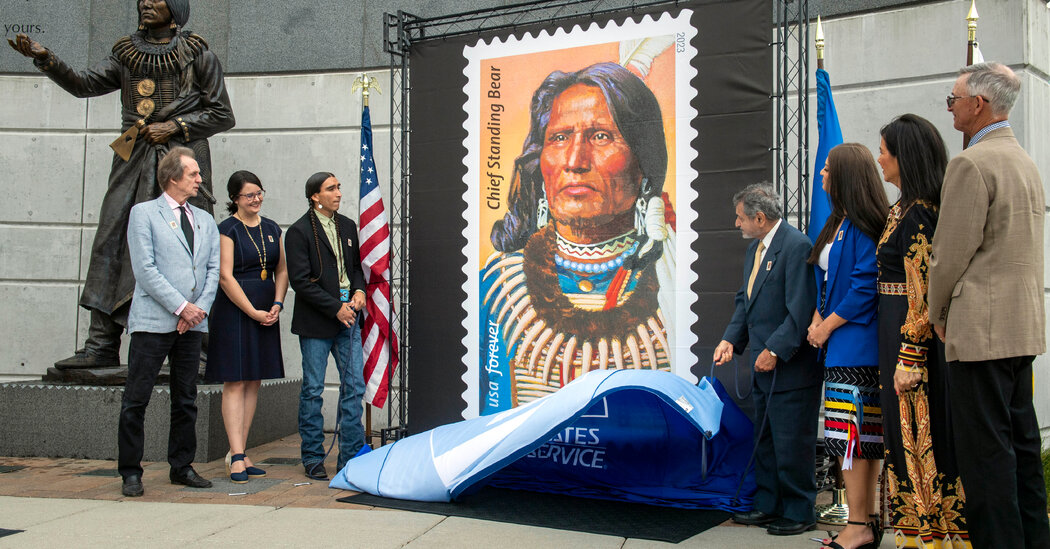Chief Standing Bear, whose 1879 lawsuit and celebrated “I Am a Man” courtroom speech led to the recognition of Native American legal rights, was honored on Friday with a Forever stamp featuring his portrait.
A leader of the small Ponca tribe in northeastern Nebraska, Chief Standing Bear successfully fought in court for Native Americans to be considered persons in the United States with the same rights to life, liberty and the pursuit of happiness as other Americans — and not as wards of the government.
The illustrated portrait of Chief Standing Bear on the stamp was based on a black-and-white photograph taken in 1877. He is depicted in the stamp wearing a bold blue shirt and a golden medallion with a background of soft orange hues faintly striated like a sunset.
In the spring of 1877, as the wars between the United States and several Plains tribes over their lands were ending and Native Americans were being driven onto reservations, the U.S. Army forcibly removed Chief Standing Bear and about 700 Ponca members from the Niobrara River Valley in what is now northeastern Nebraska.
In the roughly 600-mile journey to what is now Oklahoma, more than 100 people died, most from disease and hunger, including Chief Standing Bear’s only son.
Devastated by the loss of his child, Chief Standing Bear sought to bury his son in their homeland. In 1879, he and 29 other Ponca members traveled back to Nebraska, where they were arrested by the Army and imprisoned in Fort Omaha.
His imprisonment was the catalyst for his lawsuit, Standing Bear v. Crook, which argued for his freedom. George Crook was the general who had ordered that Chief Standing Bear and his followers be arrested.
Allies of Chief Standing Bear had filed a writ of habeas corpus asking that he be released, but government prosecutors argued that under federal law, Native Americans were not “persons” and not eligible to seek a writ of habeas corpus, according to United States Courts.
After a two-day trial, Judge Elmer Scipio Dundy of the U.S. District Court in Nebraska allowed Chief Standing Bear to speak.
The chief slowly rose from his seat, held out his hand and said through an interpreter: “My hand is not the color of yours, but if I pierce it, I shall feel pain. If you pierce your hand, you also feel pain. The blood that will flow from mine will be the same color as yours. The same god made us both.”
He stood in the courtroom, a necklace of bear claws wrapped around his neck, an eagle feather in his braided hair, and concluded his speech with four striking words: “I am a man.”
The judge agreed with that statement and issued a landmark ruling: that a Native American was a person with inherent rights under the law. Chief Standing Bear’s speech was printed in newspapers across the country, generating support for the notion that Native Americans deserved the same legal protections as other Americans.
Chief Standing Bear was eventually able to bury his son next to his ancestors near the Niobrara River.
Candace Schmidt, the chairwoman of the Ponca Tribe of Nebraska, said in a statement that the tribe was “elated that this stamp will help illustrate his story of justice and triumph, which is also our story.”
She added that the stamp served as a “symbol of the pride and perseverance for all of our members past, present and future.”
Since 2007, Forever stamps, which remain valid regardless of price increases, have honored important figures in the country whose significance has ranged from the scientific and artistic to the political and historical.
Past honorees have included former President Ronald Reagan, former Representative Barbara Jordan, the actor Gregory Peck, the singer Selena and, more recently, Toni Morrison, the acclaimed author who became the first African American woman to win the Nobel Prize in Literature.
Chief Standing Bear’s profile has grown in recent years, as several statues of him have been erected, including one in 2019 in Statuary Hall in Washington.
Judi M. gaiashkibos, executive director of the Nebraska Commission on Indian Affairs, said in a statement that the chief’s struggle and triumph “is truly and necessarily an American story.”
“This stamp further etches his legacy in our national consciousness,” she said, “and provokes necessary conversations about race, sovereignty and equality in the United States.”
